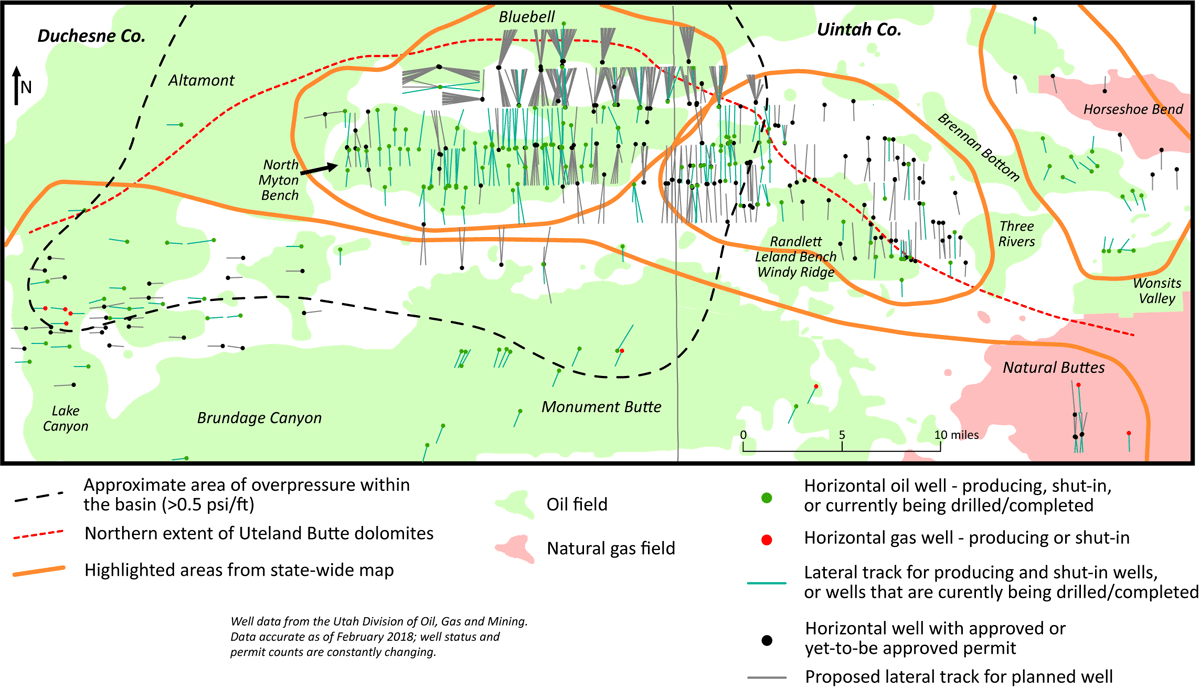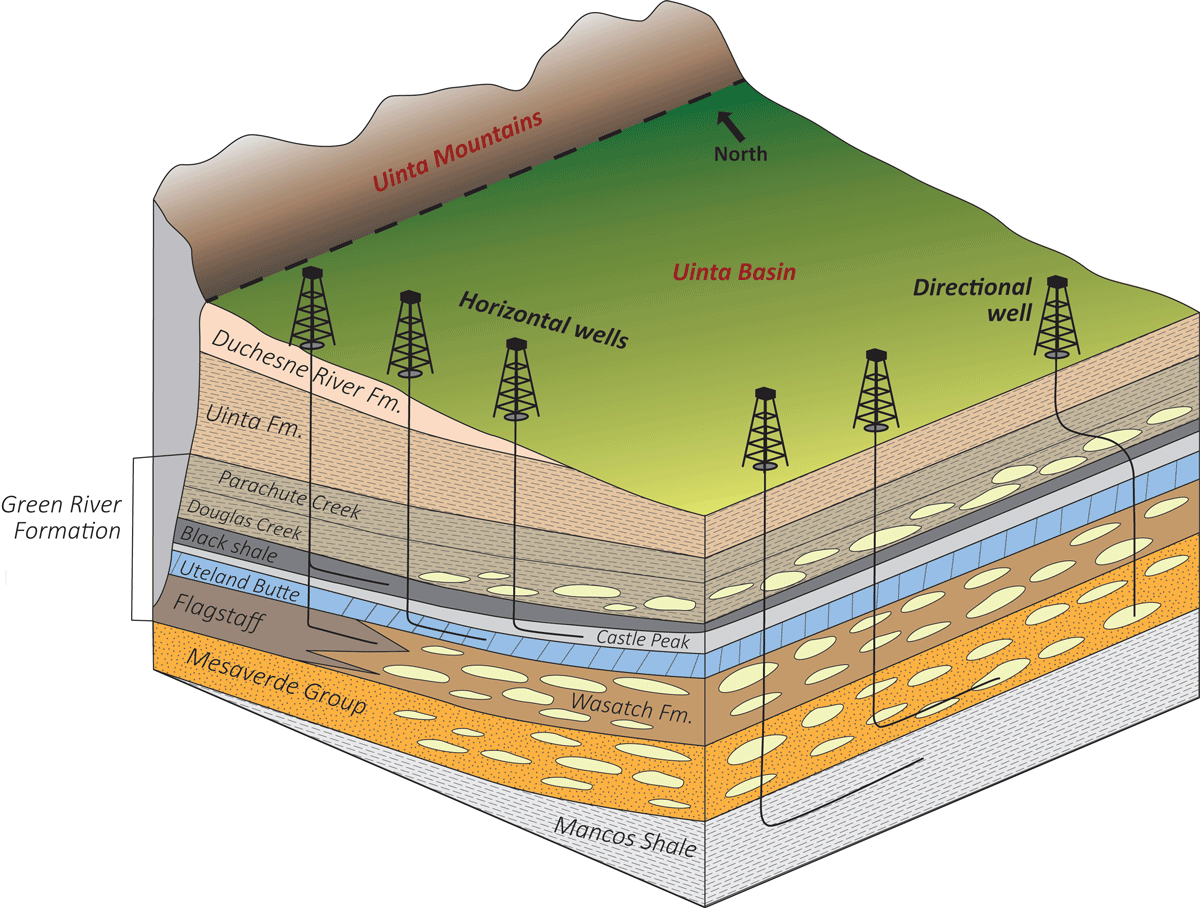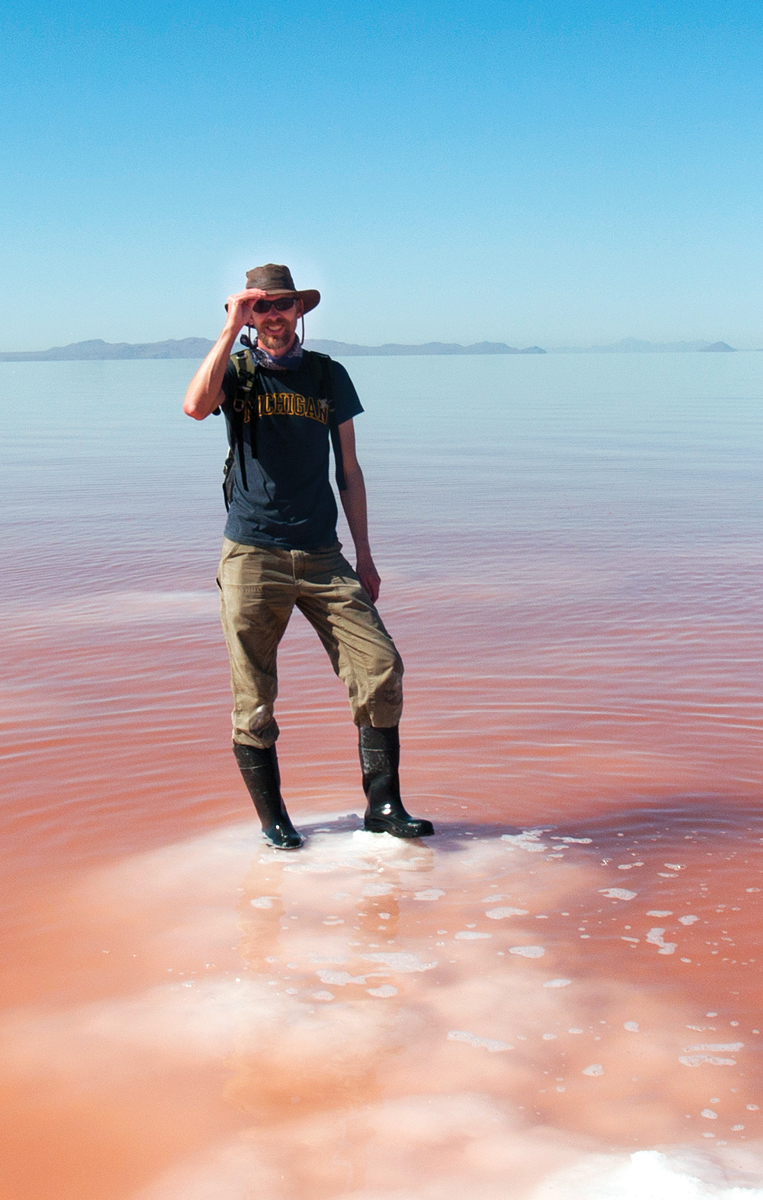Horizontal Drilling in Utah: Can Utah Compete with Surrounding States?
by Michael Vanden Berg, May 2018
Advancements in horizontal drilling and associated hydraulic fracturing have garnered significant attention in the past several years. In the past decade, the petroleum industry has combined these well-established technologies into a formidable system for exploiting domestic shale reservoirs. In fact, U.S. oil production broke 10 million barrels per day in November 2017 for the first time since production peaked in 1970. Furthermore, U.S. net imports of oil were 60 percent of total demand as recently as 12 years ago, now they are only 20 percent. This massive resurgence in oil production mostly comes from onshore unconventional shale plays such as the Permian of West Texas, the Bakken of North Dakota, the Niobrara of Colorado and Wyoming, the STACK/ SCOOP play of the Anadarko basin in Oklahoma, as well as several others. As surrounding states experience a surge in horizontal drilling, can Utah join the bandwagon? In general, the geology of Utah’s shale formations is not conducive to massive petroleum development at today’s prices and with current technology, but potential exists for smaller-scale horizontal development in regional shale play areas. Utah’s largest potential lies in the development of established conventional reservoirs using new horizontal drilling technology.

Horizontal well data from the Utah Division of Oil, Gas and Mining. Data accurate as of February 2018; well status and permit counts, especially in the Uinta Basin, are constantly changing. Oil and gas fields from UGS.
There are nearly 15,000 producing or shut-in wells in Utah; surprisingly, only about 350 target a single reservoir with a true horizontal wellbore. Directional wells are much more common, accounting for over 4000 producing wells in Utah. In contrast to horizontal wells, directional wells start out vertical, bend until they get to a desired location, then turn vertical (or nearly vertical) again when penetrating the reservoir (see illustration on page 3). Most of the producing horizontal wells in Utah are in the Uinta Basin (about 185 wells) or southern Paradox Basin (over 150 wells in the Greater Aneth field), with the remainder scattered around the central and eastern part of the state.
The first horizontal drilling in Utah occurred at the Grassy Trail field near the town of Price. Between 1982 and 1984, 18 wells with multiple short horizontal laterals (average of only 332 feet) were drilled in the Triassic Moenkopi Formation. The best eight wells were completed for an average production rate of 128 barrels (bbls) of oil per day, double the production from the vertical wells in the field (the Moenkopi in this area is still considered prospective for oil, and Whiting Petroleum drilled a horizontal test in 2012 near the town of Wellington). In the 1990s, Utah experienced a significant surge in horizontal development with extensive drilling targeting conventional carbonate reservoirs in the Greater Aneth field in southeastern Utah and more minor drilling in the Twin Creek Limestone in northern Utah.
High oil and natural gas prices in the mid-2000s and high oil prices between 2011 and 2014 spurred significant exploration in Utah’s shale deposits. During this time, the Utah Geological Survey (UGS) researched the hydrocarbon potential of various shale resource plays including the Mississippian Manning Canyon Shale, several Pennsylvanian Paradox Formation shales (Gothic, Hovenweep, and Chimney Rock), and the Cretaceous Mancos Shale, the thickest, most extensive shale unit in Utah. Despite substantial geologic research, only a handful of horizontal wells have been drilled targeting these shale formations.
In pursuit of a shale gas play in 2008, Whiting Petroleum re-entered an old vertical well and drilled a 5000-foot horizontal lateral in the Cretaceous Mowry Shale (lower Mancos equivalent) near the Utah-Wyoming border north of the Uinta Mountains. This horizontal well never produced and is currently shut-in. In 2010, Bill Barrett Corporation drilled a 4200-foot horizontal well targeting gas in the Manning Canyon Shale south of Price, Utah. Despite a significant gas “show,” this well never produced and is now plugged. Also in 2010, XTO Energy drilled a 6000-foot lateral in the middle Mancos in the central Uinta Basin. This well has produced just over 1 billion cubic feet (cf) of gas and lots of water (over 440,000 bbls), which is expensive to dispose of properly. While the well is still producing, there is currently no plan for XTO or any other company to drill other Mancos gas wells in the area.
After oil and natural gas prices crashed in 2008, the price of oil quickly rebounded but natural gas prices remained low. This caused companies to abandon most of their shale gas interest, targeting instead shale oil (or tight oil) plays. In 2013, Anadarko Petroleum drilled two horizontal wells in the suspected liquid-rich area of the Gothic shale in the south-central Paradox Basin (a third vertical well was drilled, but the planned horizontal was never completed, and two additional proposed horizontal wells were never drilled). Unfortunately, both wells (and the vertical well) are now plugged after producing only negligible volumes of oil and gas. In 2015, Whiting drilled a 4000-foot lateral in central Sanpete County targeting the Tununk Member of the lower Mancos Shale. This well produced about 24,000 bbls of oil and 74 million cf of gas before it was shut-in in mid-2017. Also, in the pursuit of a liquids shale play, KGH Operating has recently completed drilling a 12,000-foot lateral in the Mancos B (otherwise called the Prairie Canyon Member of the upper Mancos Shale) near Bonanza, Utah, in Uintah County. While results for this well are not yet available, the Mancos B has been drilled just over the border in Colorado with significant success. In addition, in early 2017, Del Rio Resources received approval for a horizontal Mancos B well in the southern part of the basin. The hope is that the Mancos B on the eastern side of the Uinta Basin could become a significant oil target as more exploratory wells are drilled to define this play.
Despite the limited success of the few exploratory wells within Utah’s shale formations, UGS research concluded that although significant potential exists, continued exploration and possibly new technologies (and higher prices) will be needed before these resource plays can significantly contribute to the state’s petroleum production.

Well data from the Utah Division of Oil, Gas and Mining. Data accurate as of February 2018; well status and permit counts are constantly changing.
In contrast to Utah’s shale plays, the Uinta Basin is poised for a significant increase in horizontal well drilling, as evidenced by the nearly 550 new horizontal well permits already approved or in the works (as of February 2018). Currently, the most important horizontal target in the basin, and all of Utah, is the lower Green River Formation. These well-known lacustrine rocks exhibit subsurface conditions especially conducive for successful horizontal development. Organic-rich petroleum source rocks are interbedded with packages of more conventional reservoir units (dolomite, sandstone), many of which are laterally continuous. Starting in 2010, operators began drilling 5000-foot laterals in these thin reservoir units in the southern part of the basin, most notably the highly porous dolomites of the Uteland Butte member (subject of a recently completed UGS research project on tight-oil potential in Utah: https://geology.utah.gov/resources/energy/oil-gas/shale-oil/). Initial production (first month) from these wells ranged from 20 to 275 bbls of oil equivalent per day (which includes natural gas), with an average of 150 bbls per day. It soon became clear that horizontal wells drilled farther north in the basin, where the beds deepen into the subsurface and the reservoir is overpressured, were more successful. Most of these lateral wells were drilled by Newfield Exploration and some by Bill Barrett, with initial production ranging from 300 to 1100 bbls per day, with an average of about 630 bbls per day. Starting in 2014, Newfield began to drill 11,000-foot horizontal laterals (over 2 miles!) in the Uteland Butte (now targeting the moderately porous organic-rich, clay-rich limestones) and in the overpressure zone, mostly in the North Myton Bench oil field. These new “super-extended laterals” experienced initial production rates of 800 to 2000 bbls per day with an average of 1285 bbls and quickly became the lateral length of preference for this part of the basin. In fact, Axia Energy has submitted plans for an extensive drilling campaign in the narrow swath of land between North Myton Bench and Bluebell fields, with multiple horizontal wells proposed to be drilled from single well pads. As the map on page 2 shows, these new super-extended laterals are clustered in an area bounded to the south by the extent of higher overpressure and constrained to the north by the pinch-out of the dolomitic reservoir units.
In addition to the Uteland Butte play, companies like Newfield, Axia, Crescent Point Energy, and QEP Resources have drilled laterals in several other units of the Green River Formation. Additional targets include the underlying Flagstaff Member carbonates, and the overlying Castle Peak siliciclastic interval, Black Shale facies, and lower Douglas Creek Member, including the informally named G1 ostracod/ooid limestone (subject of a soon-to-be-published UGS research paper). Numerous layered targets make the Green River Formation a true “stacked” horizontal play. Soon, several horizontal laterals could be drilled into multiple Green River zones in a single wellbore.
An additional horizontal target has emerged in the northeastern corner of the Uinta Basin and focuses on a conventional sandstone reservoir as opposed to a shale formation—the Cretaceous Mesaverde Group. The Mesaverde is composed of interbedded fluvial sands, overbank mudrocks, and coal beds and has traditionally been targeted for its gas resources with vertical and directional wells. Similarly, the overlying fluvial Wasatch Formation also contains significant gas resources. In fact, the largest natural gas field in Utah, Natural Buttes, produces gas from the Wasatch and Mesaverde. In 2008 and 2009, EOG Resources drilled three 4000-foot laterals, two in the Wasatch and one in the Mesaverde in the northern Natural Buttes field. To date, these three wells have produced over 4 billion cf of gas and are still producing. Then in late 2017, EOG drilled two 7000-foot laterals in the Mesaverde in the same area. Between 2014 and 2015, QEP Resources drilled two 5000-foot laterals, one 7500- foot lateral and four 10,000-foot laterals in Red Wash field targeting the Neslen unit within the Mesaverde Group. These wells have already produced a combined 24 billion cf of gas and a minor 115,000 bbls of oil. This reconnaissance horizontal drilling in the Wasatch and Mesaverde could set the stage for massive new development should natural gas prices return to higher levels.
The second hottest horizontal play in Utah, but small compared to the Green River Formation, is in the northern part of the Paradox Basin, targeting the Pennsylvanian Paradox Formation’s Cane Creek shale (also included in the recently completed tightoil project). The first vertical wells targeting the Cane Creek were drilled in the 1960s, but real commercial success started in the 1990s with the drilling of the first horizontal wells, and then greatly increased in the early 2010s when Fidelity Petroleum drilled several more horizontal wells. Currently, 24 horizontal wells are producing from the Cane Creek, most from the Big Flat field near Dead Horse Point State Park and a few minor producers farther to the southeast. The most successful well, Cane Creek Unit 12-1, was drilled in 2012 with an initial production rate of about 1700 bbls of oil per day and to date has produced just over 1 million bbls. Fidelity has since sold their Cane Creek acreage to Kirkwood/WESCO Operating, who currently have 25 approved horizontal well permits on file.
Horizontal well drilling is not new to Utah; it has been an established technology since the early 1980s. With high natural gas prices in the mid-2000s, several companies drilled exploratory horizontal wells in Utah’s potential shale gas plays, but as the price of gas crashed in 2008, these targets were no longer pursued. As the price of crude oil rose in the early 2010s, companies refocused their efforts on liquid-rich plays in established basins but with new horizontal drilling targets and techniques (e.g., longer laterals). By far the most successful of these plays is within the Green River Formation in the Uinta Basin, and to a lesser extent, the Cane Creek play in the northern Paradox Basin. Other shale plays (Manning Canyon, Gothic, Mowry, Mancos) and horizontally- targeted conventional reservoirs (Wasatch, Mesaverde, Moenkopi) will need further research and possibly technological advances (and higher prices) before Utah can compete with the Bakken of North Dakota or the Permian of West Texas.
For more information on recently completed UGS shale research, visit the Oil and Gas section of our website: https://geology.utah. gov/resources/energy/oil-gas/.
ABOUT THE AUTHOR
Michael Vanden Berg
has worked at the Utah Geological Survey for 15 years and is currently the Energy and Minerals Program Manager. In addition to his
managerial duties, Michael researches the lacustrine deposits of the Green River Formation, including their hydrocarbon potential, as well as modern lacustrine systems such as Great Salt Lake. Michael is also the General Chair for the upcoming AAPG Annual Convention in Salt Lake City, May 20–23.











